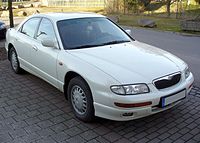Mazda Millenia
This article relies largely or entirely on a single source. (August 2019) |
| Mazda Millenia | |
|---|---|
 1998–2000 Mazda Millenia | |
| Overview | |
| Manufacturer | Mazda |
| Also called |
|
| Production | 1993–2002 |
| Assembly | Japan: Hiroshima (Hiroshima Plant) |
| Designer | Yujiro Daikoku (1990)[1] |
| Body and chassis | |
| Class | Executive car |
| Body style | 4-door sedan |
| Layout | Front-engine, front-wheel-drive |
| Platform | Mazda TA platform |
| Powertrain | |
| Engine |
|
| Power output |
|
| Transmission |
|
| Dimensions | |
| Wheelbase | 2,751 mm (108.3 in) |
| Length |
|
| Width | 1,770 mm (69.7 in) |
| Height | 1,394 mm (54.9 in) |
The Mazda Millenia is an
from 1993 to 2002.The Millenia was originally planned as the second of three models for Mazda's proposed luxury brand
Having been developed for a separate market from typical Mazda customers, the Millenia boasted myriad finer details. It was engineered to far greater levels of perceived quality than existing Mazda cars, such as interior plastic quality, panel gap and thicker paint coating. The Millenia/Eunos 800/Xedos 9 was assembled along with the smaller
The Millenia does not have a direct predecessor or replacement in the Mazda product line, and production ceased with the introduction of the
The 1997 Japanese market name change from Eunos 800 to Mazda Millenia was accompanied by a significant facelift that included some cost-saving measures. For instance, the
European designation
The Mazda Xedos 9 was a luxury car for Mazda of Europe. Sold between 1993 and 2002, the Xedos 9 was the export version of Mazda's upscale Eunos 800 on the Mazda T platform.
Engines:
- 2.5 L KL-DE V6
- 2.25 L KJ-ZEM V6 (Miller cycle)
- 2.0 L V6, same as the unit found in the Xedos6
Japanese designation
The
Engines:
- 2.5 L KL-ZE V6
- 2.25 L KJ-ZEM V6 (Miller cycle)
North American market
The car was launched in
Engines:
- 2.5 L KL-DE V6
- 2.3 L KJ-ZEM V6 (Miller cycle) (slightly modify version of the 2.25 L version sold in other markets but has same engine code)
Eunos 800M SP
Mazda Motorsport Australia released a limited edition Eunos 800M SP with improved suspension and larger alloy wheel and tyre combination, but with no modifications to the engine.
Gallery
-
Mazda Xedos 9 (Europe)
-
Eunos 800 2.5 (pre-facelift)
-
1998-2000 Mazda Millenia (Japan)
-
1998-2000 Mazda Millenia (Japan)
-
2001-2002 Mazda Millenia (US)
Amati
The first mention of the Amati luxury brand was in Motor Trend magazine February 1992 page 118, the article written by Maryann N. Keller. In the June 1992 issue, the Amati logo was displayed in green, and they mentioned that the advertising campaign was to be handled by Los Angeles based Lord, Dentsu & Partners who had an advertising campaign budget of $75 million, with a launch to be slated at the end of 1993. The November 1993 issue on page 18 stated that after Amati had been cancelled due to recession, the Millenia was originally to be sold as an Amati.
Production for the Millenia ended in 2002, without replacement.
Engines:
- 2.5 L KL-DE V6
- 2.3 L KJ-ZEM V6 (Miller cycle) - 217 bhp (162 kW)
Specifications and performance
| Specifications | Millenia S | Millenia L (and Base) [2] |
|---|---|---|
| MSRP | $35,595 | $31,995 (Millenia L) |
| Engine Type | 2.3 Liter V6 | 2.5 Liter V6 |
| Engine Size | 2255 cc/2.3 L | 2497 cc/2.5 L |
| Horsepower | 210 hp (157 kW) @ 5300 rpm | 170 hp (127 kW; 172 PS) @5600 RPM |
| Torque | 210 lb⋅ft (285 N⋅m) @ 3500 rpm | 160 ft⋅lbf (220 N⋅m) @ 4000 RPM |
| Wheelbase/Width/Length | 108.3 in (2,751 mm)/69.7 in (1,770 mm)/189.8 in (4,821 mm) | 108.3 in (2,751 mm)/69.7 in (1,770 mm)/189.8 in (4,821 mm) |
| Transmission | Four-speed automatic | Four-speed automatic |
| Curb Weight | 3,410 lb (1,550 kg) | 3,232 lb (1,466 kg) |
| Fuel Type | Premium Unleaded | Premium Unleaded |
| Fuel Capacity | 18.0 US gal (68 L; 15 imp gal) | 18.0 US gal (68 L; 15 imp gal) |
| Tires | P215/50R17 | P215/65R15 (Millenia L) |
| Brakes (F/R) | Disc (ABS)/Disc (ABS) | Disc (ABS)/Disc (ABS) |
| Drivetrain | Front-engine/front-wheel-drive | Front-engine/front-wheel-drive |
| Vehicle Type | Five-passenger/four-door | Five-passenger/four-door |
| Domestic Content | 4% | unknown |
| Coefficient of Drag (Cd.) | 0.29 | 0.29 |
| Performance | ||
| EPA Economy, miles per gallon city/highway/average |
20 mpg‑US (12 L/100 km; 24 mpg‑imp)/28 mpg‑US (8.4 L/100 km; 34 mpg‑imp)/23 mpg‑US (10 L/100 km; 28 mpg‑imp) | 20 mpg‑US (12 L/100 km; 24 mpg‑imp)/27 mpg‑US (8.7 L/100 km; 32 mpg‑imp)/22 mpg‑US (11 L/100 km; 26 mpg‑imp) |
| 0-60 mph | 7.5 seconds | 9.9 seconds |
| 1/4 Mile (E.T.) | 15.8 seconds @ 93.8 mph (151.0 km/h) | 17.3 seconds |
| Top Speed (Est.) | 142 mph (229 km/h) | 135 mph (217 km/h) |
References
- ^ Daikoku, Yujiro. "USD353792S". Google Patents. Mazda. Retrieved 2019-09-19.
- ^ "Detailed specs review of 1996 Mazda Millenia model for North America".





